The world is replete with intriguing mysteries, yet scientists are now confident they’ve unraveled one linked to an ancient civilization on Easter Island.
On platforms like YouTube, you can find countless discussions about the planet’s most enigmatic wonders.
Discussions frequently revolve around iconic sites like Stonehenge or the pyramids. However, the colossal statues of Easter Island in Chile might not receive as much attention, primarily because experts now believe they’ve discovered how these massive structures were transported.
For those unfamiliar, these statues, known as Moai, which weigh between 12-14 tons, have baffled researchers and scientists for years. While they appear to be mere giant heads above ground, many of these statues are actually full-bodied, with only the heads visible.
We know that the Rapa Nui people from eastern Polynesia crafted these statues between 1250 and 1500, but the method of their transportation across the island had long remained a mystery.

Recent findings have shed light on this mystery, with researchers even demonstrating how the people might have maneuvered these incredibly heavy structures.
Carl Lipo, a Professor of Anthropology at Binghamton University, along with Terry Hunt from the University of Arizona, has been examining these monoliths. They propose that the Rapa Nui people likely employed a rope and pulley system to make the statues ‘walk’ down specially prepared roads.
Lipo explained: “Once you get it moving, it isn’t hard at all – people are pulling with one arm. It conserves energy, and it moves really quickly.
“The hard part is getting it rocking in the first place. The question is, if it’s really large, what would it take? Are the things that we saw experimentally consistent with what we would expect from a physics perspective?”
When put into practice, the method is quite remarkable, as the statue seems to waddle side to side toward its destination.
The research team constructed their own 4.35-ton replica Moai and, using just 18 individuals, successfully made the statues cover a distance of 100 meters in only 40 minutes.
Lipo further noted: “The physics makes sense. What we saw experimentally actually works. And as it gets bigger, it still works. All the attributes that we see about moving gigantic ones only get more and more consistent the bigger and bigger they get, because it becomes the only way you could move it.”
He also pointed out that the roads align with the notion that the statues were transported this way.
“We actually see them overlapping each other, and many parallel versions of them. What they are probably doing is clearing a path, moving it, clearing another, clearing it further, and moving it right in certain sequences. So they’re spending a lot of time on the road part.”
The team is so convinced of their findings that Lipo has issued a challenge for anyone to prove otherwise.
“Find some evidence that shows it couldn’t be walking,” he stated. “Because nothing we’ve seen anywhere disproves that.”

